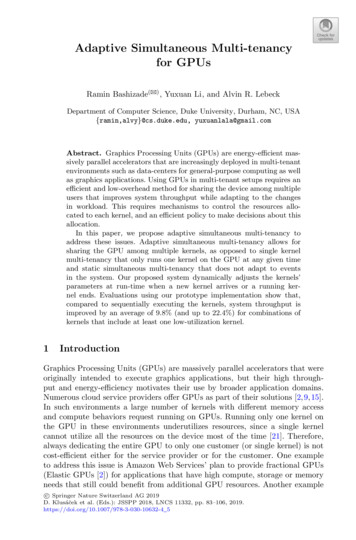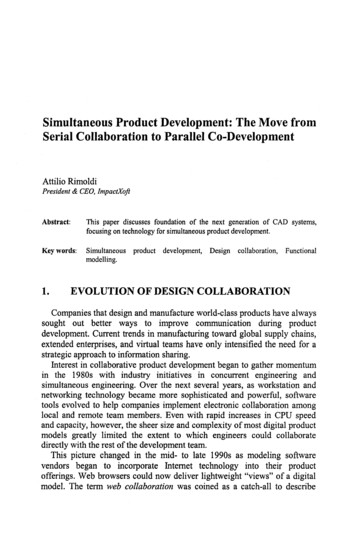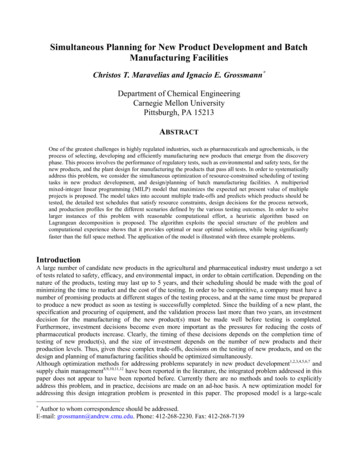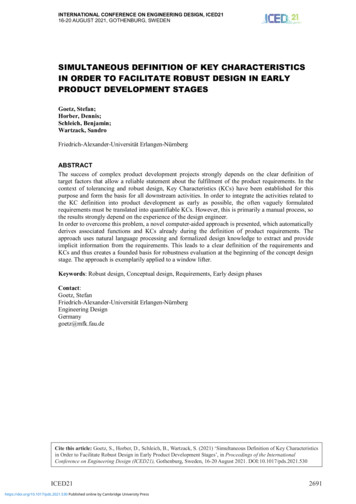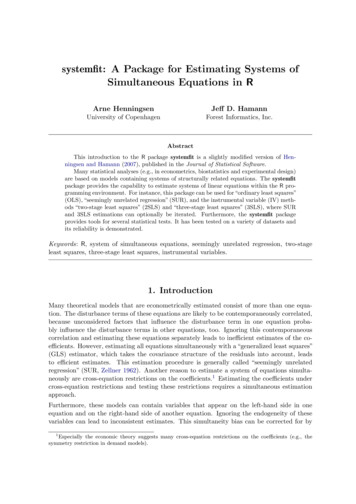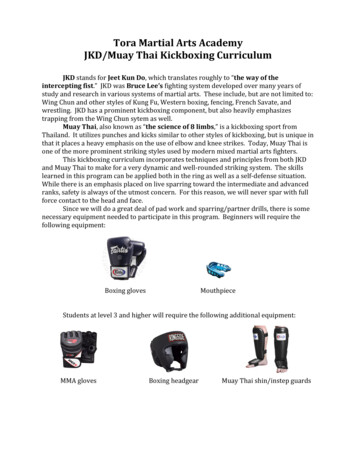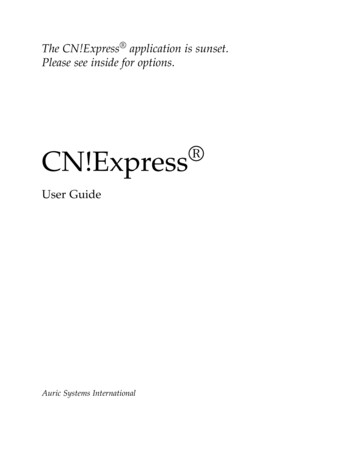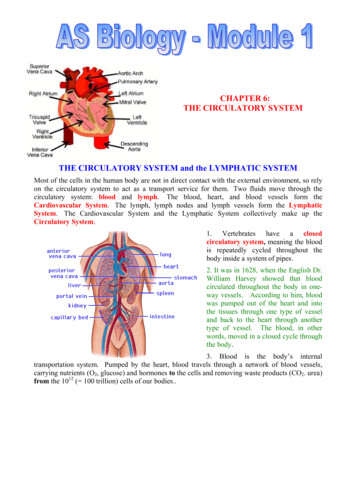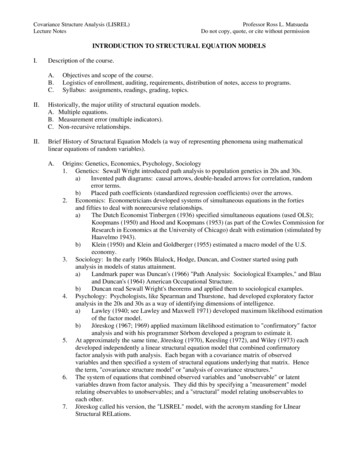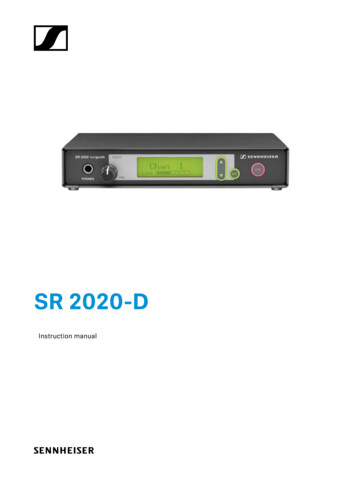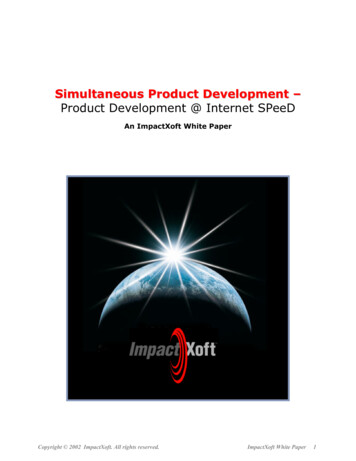
Transcription
Simultaneous Product Development –Product Development @ Internet SPeeDAn ImpactXoft White PaperCopyright 2002 ImpactXoft. All rights reserved.ImpactXoft White Paper1
Simultaneous Product Development –Product Development @ Internet SPeeDAn ImpactXoft White PaperPAGECONTENTS3Introduction5Part I: Simultaneous Product Development 1015COLLABORATION EVOLVES556Stage 1 Collaboration: SerialStage 2 Collaboration: Still SerialStage 3 Collaboration: Simultaneous6PRODUCT MODELING EVOLVES677Explicit Modeling: FormParametric Modeling: Form and FitFunctional Modeling: Form, Fit, and Function9Part II: The Practice of Simultaneous Product Development9WHAT IT ISN’T10WHAT IT ltaneous14Part III: The Tools of Simultaneous Product Development14UNDERLYING TECHNOLOGIES141616IX Functional ModelingIX Functional Object RepresentationIX Design Intent Merge18IX SPEED SUITE19Part IV: More Earthquakes and evelopmentDevelopmentDevelopmentCopyright 2002 ImpactXoft. All rights reserved.IsIsIsIsGlobalParallelSynchronous and AsynchronousRole SpecificImpactXoft White Paper2
Simultaneous Product Development –Product Development @ Internet SPeeDAn ImpactXoft White PaperHere’s a new way to set a world track record: Get all the members of your relay team to runtheir laps together at the same time rather than separately one by one.The idea of changing a relay race into a parallel race might not appeal to the Olympic rulescommittee. But as a new approach to product development, the concept of working in parallel– or simultaneously – holds tremendous promise for many companies.The practice of Simultaneous Product Development has arisen to address longstandingchallenges in the race for market share. A list of these challenges will be familiar to anyonewho has been involved in product design and development over the last decade. Develop products that customers want and deliver them on scheduleCoordinate suppliers and partnersManage the product life cycle (design requirements planning through fieldservice and retirement)Encourage product innovation and qualityMinimize design and development cycle time and costUtilize emerging technologiesMany companies have found meeting these goals to be a frustrating and difficult process. Asproduct development becomes increasingly global, the problems seem only to intensify. Evenafter installing the latest ERP system and the latest collaboration portal, product developmentstill bogs down with engineering change orders and unproductive rework. Suppliers make partsthat don’t fit or suddenly run out of inventory. Outsourced design teams sit on their handswhile marketing revises requirements. Production dates slip and scrap costs mount whilemanufacturing engineers fix digital part models to adjust to material and machiningcapabilities.Why have problems such as these been so persistent in product development? We believe theanswer lies in the relay mindset that pervades industry even today. Despite all the attentionpaid lately to the concept of collaboration, product design and development practices stillfollow old habits of seriality formed back in the step-by-step days of paper records. Then,product development proceeded along well-worn grooves as a design was handed like a batonfrom one development function to the next or, in an oft-repeated phrase, was “thrown over thewall” to the next workgroup. During the nineties, the movement toward simultaneousengineering, also known as concurrent engineering, documented vast stretches of wastedtime, isolated pockets of information, and huge avoidable costs associated with this serial wayof working.The pioneers of concurrent engineering made some inroads into integrating design andmanufacturing functions. But that was before the Internet. The instantaneous, round-the-clockcommunication it enables has changed everything. Seriality is being left in the dust. Via emailand web technology, product development teams scattered all over the world are makingdesign decisions faster than ever, leaping over time zones and traditional knowledge-sharingprocedures in an effort to break the stranglehold of seriality and reap the benefits of working inparallel.Copyright 2002 ImpactXoft. All rights reserved.ImpactXoft White Paper3
This is just the beginning of the era of Simultaneous Product Development. Resourceful andambitious companies will achieve it, and they will use it as a strategy to accomplish thebusiness goals outlined above.The rest of this paper explores the concept of Simultaneous Product Development and explainssome of the revolutionary technologies that make it possible. Our idea is really quitestraightforward. When you are working faster than ink can dry, you stop using ink and invent atool that can keep up. In the following pages, we describe the tools we’ve created to usherproduct design and development into this new age.Copyright 2002 ImpactXoft. All rights reserved.ImpactXoft White Paper4
Part I: Simultaneous Product Development 101Like any other human endeavor, product design and development has a history that containsboth earthquakes and evolutions. The arrival of innovative technology often has a seismicaffect on industry, followed by a longer period during which companies test, implement, andmaster new tools. As current technologies and business practices mature, another wave ofinnovation is usually gathering. Tools that bring about earthquakes in product developmentpractices are sometimes called “disruptive.” But the emergence of new tools is a sign that theunderlying needs of product developers have naturally evolved and must be readdressed.COLLABORATION EVOLVESBy enabling the move from serial to parallel work processes, Simultaneous ProductDevelopment culminates three stages of collaboration that have evolved over time. From stageto stage, product development needs have grown more sophisticated. Companies continue toseek ways to sharpen their response to business demands.Stage 1 Collaboration: SerialIn the earliest stage of collaboration, product developers communicated by means of postalmail, telephone, fax machine, and face-to-face meetings. Design documentation was paperbased, and development work proceeded step by step. Using CAD software, engineers modeledproducts, printed drawings for delivery to other team members, gathered comments, and thenrevised the CAD model for the next round of review.Over the last decade, many organizations found it necessary to advance beyond this timeconsuming method of collaboration as development cycles shrank and as customers andsuppliers became more diverse.Stage 2 Collaboration: Still SerialIn the next stage of collaboration, tools expanded to include email, Internet chat,teleconferencing, and web-based meetings. Internet communication increased as productdevelopment became globalized. Most design documentation now resided in databases, and anelectronic version of the CAD product model was available for browser-based design review.Using the Web, development team members in different physical locations could meet virtuallyto confer on designs together and to view and mark up CAD models. Web-based design reviewshelped many development teams work more efficiently.However, once the Web-based review concludes, efficiency gains evaporate. The developmentprocess reverts to first-stage collaboration. A CAD expert again must interpret reviewcomments and redo the product model. Many companies realize that this separate step of CADmodeling, which requires specialists to painstakingly construct the detailed geometry ofproducts, is a bottleneck that slows product development. Until now, there has been no way toavoid it.Copyright 2002 ImpactXoft. All rights reserved.ImpactXoft White Paper5
Stage 3 Collaboration: SimultaneousRemember the earthquake mentioned above? That rumble is the sound of ImpactXoftintegrating CAD modeling with Internet collaboration to inaugurate the era of SimultaneousProduct Development. We have created technology that eliminates digital modeling as aseparate, poorly connected island in product design. Our software enables every member ofthe development team to work as a node of a network and produce complete geometryautomatically by simply adding, subtracting, or modifying product features. Every change ismerged into the actual digital model rather than to a copy. And every change merges perfectly,even over low-bandwidth connections, with model alterations made by other team members.Because ImpactXoft technology demolishes the last outpost of seriality in product development,it will finally enable collaboration in the true sense of the word. Simultaneous ProductDevelopment answers the needs of today’s and tomorrow’s globally dispersed developmentteams to work more closely and more quickly than ever.PRODUCT MODELING EVOLVESProduct modeling tools themselves have gone through three stages of evolution, causing majorshifts in the market for CAD software about every fifteen years (see Figure A). A brief look atthese stages will identify some of the reasons that CAD systems have played such an indeliblerole in product development. It will also become clear that the age of specialized CAD modelingas a separate function in engineering – as an isolated “island of automation” – is decidedlyover.Figure A. Product modeling technology has evolved over time.Explicit Modeling: FormExplicit modeling is the practice of adding, subtracting, and combining lines, surfaces, andsolids to create a product design. In the 1970s, the first CAD systems automated explicitmodeling so that designers could define the form of a product electronically. The greatlimitation of explicit modeling is the time required to revise geometry. For example, if theshape of one part changed, the shape of the surrounding parts in the product assembly had tobe accordingly reworked. Explicit modeling answered an early need for design automation, butit was only the beginning.Copyright 2002 ImpactXoft. All rights reserved.ImpactXoft White Paper6
Parametric Modeling: Form and FitIn the 1980s, parametric modeling was a powerful advance over explicit modeling, since itprovided a way to also define the fit between the different elements of a product design. Nowdesigners could not only create the shape of the product but could also determine which designelements were related such that a change in one would automatically bring about a change inthe other. Design elements so related were said to be constrained. To speed up the process ofreworking geometry as design progressed, parametric modelers recorded every step in thehistory of a design as it occurred. Changes were made to the variables that defined the modelgeometry, this history tree was replayed, and the model regenerated onscreen according to itsnew design parameters.Parametric modeling shaved a considerable amount of time off the reworking of productgeometry, but it introduced a new problem: it was hard to do. More importantly, it was hard toundo. The history-based approach to digital modeling introduced an inflexibility into productdevelopment that lasted well into the 1990s. The historical order of operations wasfundamental to the proper regeneration of the model, but design changes often hadunpredictable results when the history was recomputed. Selective breaking and remaking ofconstraints sometimes solved the problem, but designers who did not have special CAD systemknowledge lost a lot of time trying to revise designs. Development team members with no CADknowledge didn’t even try.Interestingly, some parametric systems that emerged at this time were not history-based.Called variational modelers, they allowed designers to create and revise model geometry in anyorder. Feature-based modeling was another advance that sped development. Modeling featuresare predefined packages of geometry rules for such widely used design elements as holes andfillets that can be attached to solid models and created automatically with a single command.Features now are regularly included in most modeling systems.Functional Modeling: Form, Fit, and FunctionFunctional Modeling is the breakthrough technology that opens the next evolutionary stage. Itadvances on parametric, history-based modeling by introducing two innovations. First of all,Functional Modeling is history independent, which means that design elements added,subtracted, and modified in any sequence will always generate the same product model. Thereis never any need to go back and reorder the history tree for the desired modeling result.Second, Functional Modeling is based on the use of functional features. Unlike the geometricfeatures included in traditional modelers, functional features have built-in intelligence thatpredefines how design elements function in the overall design – that is, how they relate to oneanother and behave in response to design changes.Functional Modeling helps realize the long-awaited promise of letting designers work creativelyand spontaneously in accordance with the way they think, not the way a modeling systemrequires them to think. The result is that designers raise their conceptual focus from geometryconstruction (“How do I build it?”) to design function (“Why build it this way?”). And becauseFunctional Modeling prevents project teams from getting bogged down in geometrical details, itis the perfect modeling approach for the era of Simultaneous Product Development.Functional Modeling is only one of three patent-pending ImpactXoft technologies that supportthe practice of Simultaneous Product Development. We explain these three interlockingtechnologies in detail in Part III. Here they are in brief:Copyright 2002 ImpactXoft. All rights reserved.ImpactXoft White Paper7
IX Functional Modeling Enables a more logical approach to modeling focused on the ultimate functionality of thedesign. Takes product definition beyond the engineering realm to make it accessible to allmembers of the development enterprise. Product designs are created and modified morequickly, even by nontechnical personnel formerly excluded from the process.IX Functional Object Representation Represents model objects as small bundles of intelligent data containing the “recipe” forconstruction. Enables real-time collaboration on product definitions, regardless ofbandwidth. The full intelligence of part geometry travels readily over the Internet so work isshared almost instantaneously with others.IX Design Intent Merge Intelligently translates only the required model data to be merged between globalsynchronous and asynchronous development sessions. Enables the fast and efficientexchange of model updates. Multiple design modifications blend automatically into theproduct model that each project member sees.Innovation in design and manufacturing technology comes in waves, in response to changingbusiness problems. But the fundamental business challenge remains. You need to developproducts that customers want and get them to market faster and at less cost than yourcompetitors. Interesting technologies will continue to evolve to address this need.Copyright 2002 ImpactXoft. All rights reserved.ImpactXoft White Paper8
Part II: The Practice of Simultaneous Product DevelopmentSimultaneous Product Development has four main characteristics that distinguish it fromconventional collaborative nous and asynchronous.role specific.It’s useful to look at each one of the characteristics more closely, given the many conflictingclaims about collaborative product development being made in the technology marketplacetoday. But first, let’s take a look at what the practice of Simultaneous Product Development isnot.WHAT IT e dependent.model-history dependent.bandwidth dependent.Team communication has certainly always been vital to product development, and the rise ofthe Internet has encouraged many companies to investigate web-based tools as a vehicle forimproving time to market. But “collaborative” does not necessarily mean “simultaneous.” Mostcurrent tools for collaborative product development perpetuate the older tradition of seriality inwhich they are embedded. This means that they reinforce the very practices that robcompanies of productivity. Project teams using these tools are still subject to the limitations oftime-zone geography, history-based modeling systems that only experts can operate, and lowbandwidth connections.For example, some packages for CAD modeling and product data management allow teams tosend complete product models over the Internet. File-sharing systems such as these are usefulin conveying complete CAD geometry to multiple engineers. But CAD models are huge, andthey take so long to download that it makes no sense to pass them around for comment. As aresult, project members work on copies and hope their changes show up in the master model.In addition, because expertise with the modeling system is required, all but experiencedengineers are typically excluded from firsthand participation in design. Personnel from sales,marketing, procurement, and production have important information to contribute whileproducts are under design, but their lack of expertise with CAD systems often shuts them outof the process. Companies often trace the source of expensive late-stage design changes todelayed feedback from a vital member of the project team.CAD visualization tools and view-and-markup packages have arisen to address this. Theseweb-enabled tools allow multiple users from various disciplines to interactively view andmanipulate image representations quickly via a browser. The problem is that project memberswork with simplified pictures of the geometry from which much of the model intelligence hasCopyright 2002 ImpactXoft. All rights reserved.ImpactXoft White Paper9
been stripped away. A CAD specialist must come along after they record their comments andmust make all the changes directly to the product model before development can resume.Other systems provide a virtual meeting room on the Web so that all project members canview and manipulate a complete product model and discuss design problems in real time.However, what looks simultaneous is really serial: one participant at a time controls the modelwhile others wait to do their own work. As with view-and-markup systems, most changes tothe model must then be transferred into the CAD system. One of the problems with the webbased design review is the inconvenience it causes for project members located across timezones. These systems usually force someone to be working at an unfortunate hour.Competition for Internet bandwidth can also degrade meeting performance for remote teammembers.A growing number of design and manufacturing enterprises are hindered by the constraints ofsoftware that is “collaborative” in name only. They will recognize the benefits of SimultaneousProduct Development and use it to their advantage.WHAT IT ISVery simply, Simultaneous Product Development is a method of concurrent engineering inwhich members of the entire global development chain work in parallel to create and finalizeproduct definitions. Another term used to describe it is parallel co-development. The distinctionbetween serial and parallel development may seem subtle at first, but the transformation itinvolves is akin to rounding a riverbend. Opportunities await product teams that enter this newworld.Simultaneous Product Development Is GlobalNot so long ago, products were developed by engineers who worked elbow to elbow. Designerssat together in engineering bullpens next to an adjoining factory. But the days of physically colocated operations are numbered. Fewer and fewer companies operate under one roof.Manufacturers are increasingly decentralized, with production facilities and productdevelopment teams located all over the world.Simultaneous Product Development replicates all the virtues of physical co-location and appliesthem in a global context. Distributed teams can leverage the core competencies of partners,locate facilities close to customers, and take advantage of local resources to bring innovativeproducts to market faster and at less cost. At the same time, development unfolds like a groupconversation. No participant is inadvertently left out. Even when your mechanical engineers arein Los Angeles, your electrical engineers are in Chicago, your moldmakers are in Taiwan, andyour assembly operations are in Mexico, all these specialists can work just as closely togetheras if they were in the same room.In many industries, OEMs are delegating more design responsibility to subcontractorsthroughout the supply chain and are pulling in strategic partners and customers. Mechanicalengineers, electrical engineers, and industrial designers must share detailed knowledge of partgeometries, clearances, tolerances, materials, and other variables. Manufacturing engineersmust provide continual feedback on how evolving components can be produced and assembled.Procurement must walk hand in hand with suppliers worldwide. Marketing and sales expertsmust be able to influence a design before it goes off the tracks.Copyright 2002 ImpactXoft. All rights reserved.ImpactXoft White Paper10
The information load is intense for activities throughout the product lifecycle. Without the righttools, collaboration is the Achilles heel of globally dispersed development teams.Simultaneous Product Development Is ParallelFigure B depicts the time and cost savings that are theoretically possible when productdevelopment proceeds in parallel rather than according to the traditional sequence. The timesavings add up radically to compress the development cycle when activities run concurrently.As we discussed earlier, the ideal of concurrent product development is not new. Up till now,it’s just been out of reach. The practice of Simultaneous Product Development wrestles theideal down to earth and brings it within grasp.Figure B. Simultaneous Product Development reduces time to marketby promoting concurrency across the entire product lifecycle.A vital insight was required: digital product modeling had to be reinvented for design teams.Companies increasingly rely on digital models to carry the complete product definition, but fewproject members outside of engineering can open a CAD model and make a necessary change.CAD modeling has sometimes been a troublesome adventure even for engineers.Simultaneous Product Development is based on the premise that specialists from every area –design, manufacturing, procurement, quality control, service and maintenance, sales andmarketing, and so on – should be able to contribute directly during product design. In this way,product definition can proceed as quickly and efficiently as though all these experts weretogether in the same room, discussing issues, making recommendations, and resolvingproblems. These experts are not just shown the design in a visualization tool and asked torecord opinions or notations that someone else must later interpret and insert in a mastermodel. They actually interact with the geometry and remodel the product themselves.Copyright 2002 ImpactXoft. All rights reserved.ImpactXoft White Paper11
The modeling software should be easy to use, so that product experts who have no experiencewith digital modeling – and who as a result have traditionally been excluded from vitalmodeling decisions – can work concurrently with modeling specialists. The authoring toolshould simplify the design process and reduce the emphasis on geometry creation, so evenCAD novices can easily revise the original model. Designers and other professionals familiarwith modeling software can work with part geometry much faster than is possible in aconventional CAD system.Simultaneous Product Development Is Synchronous and AsynchronousThe terms synchronous and asynchronous describe two different modes of development usedby globally dispersed product teams.In synchronous development, project members log on together at thesame time to a scheduled design session.In asynchronous development, project members work offline at differenttimes and log on whenever they are ready to post their contributions.As we explain below, synchronous and asynchronous mean different things depending onwhether the tools that implement collaboration are serial or simultaneous. Using serial tools forsynchronous development– view and markup software, virtual meetings, and so on – severelylimits the productivity of teams. Everyone might be logged onto a meeting site at the sametime, but the synchronism stops there. Participants must wait their turn to work directly on theproduct model or must pass along to others comments that are later incorporated into themodel.In contrast, Simultaneous Product Development allows project members logged onto a designsession at the same time to all work directly on the product model at the same time. This is thetrue definition of synchronous. It means simultaneous. They can all do their own work on thesame model at the same time without interfering with one another. In synchronous mode,project members work on their respective models at their own pace and then broadcast andmerge their additions and changes. The models of other project members are automaticallyreconciled with their own. Only ImpactXoft technology makes this possible.Project members who choose the asynchronous mode of Simultaneous Product Developmentare especially free from the limitations of serial tools. Asynchronous collaboration is often themode of choice when the development enterprise spans time zones. But problems arise whenpeople work offline at their own locations and then try to compile ideas. An expensive andtime-consuming layer of administrative control is usually required to enforce the order in whichproject members can make changes and to later reconcile inconsistent design suggestions.ImpactXoft technology erases the need for this step-by-step control and thereby transformsasynchronous collaboration into true parallel co-development.Here’s how it works. A mechanical engineer in the New York broadcasts her updated productmodel over the server on a Tuesday evening. Nine hours later, when the industrial designer inIndia logs onto the project, he receives her updates and merges them into his own design,simply by clicking on her update package sitting in the inbox. Without missing a beat, hecontinues to develop the product and then broadcasts his updates to the project team. A fewhours later, when the marketing director in France logs on, he easily merges the engineer’s andthe designer’s changes to check the developing product against customer requirements. Hethen broadcasts his own updates. On Wednesday morning, when the engineer logs on againCopyright 2002 ImpactXoft. All rights reserved.ImpactXoft White Paper12
from her location in the United States, she merges the designer’s and the marketing director’supdates to examine the model for new structural issues that may have arisen.Meanwhile, other team members located elsewhere in the world are receiving and broadcastingupdates to the product model just as easily. They can receive notes or documentation fromother project members, as well as review a list of all the model updates that have occurredsince they last logged on. They can perform modeling operations while offline and then log onwhenever they are ready to share their contributions. This type of asynchronous development,the truest manifestation of “around the clock” product design, has never been so simultaneous.Simultaneous Product Development Is Role SpecificThe members of any product team contribute specialized knowledge according to theirexpertise and role in the project. But the members of Simultaneous Product Developmentteams are able to contribute in parallel because they all have the opportunity to performhands-on modeling. Production specialists make ongoing updates regarding assembly andfabrication on the factory floor. Industrial designers correct the aesthetics of a product modelas it evolves. Sales and marketing personnel revise digital designs to match market demandand the voice of the customer. Quality experts adjust models to comply with company andindustry standards. Procurement specialists access geometry to check if outsourced parts willfit.Project members see whatever model components are pertinent to their specific role indevelopment. They focus on their individual development tasks and then merge theircontributions with those of others, as appropriate.For example, because an industrial designer focuses on external shape, his view of a productmodel will differ from that of a mechanical engineer, who is concerned with structural integrity.The designer must send shape changes to the engineer, but the engineer need not sendstructural revisions back to the designer because they don’t affect external aesthetics. Themodel the designer works with might be a solid that is not split or shelled. On the other hand,the engineer would see the very same model with the split, shell, and ribs displayed. In thesame way, the project coordinator could configure her settings to automatically view allupdates to the model that are posted to the server. She might want to see the contributions ofthe designer, the engineer, and all other project members. Her model would show all themerged data.As you can probably imagine by now, Simultaneous Product Development enables global teamsto run quickly through “what-if” scenarios. Together, project members can generate ideas thatnever occur to specialists working in isolation. They can speedily air concerns aboutrequirements, manufacturing, testing, service, and so on. With ImpactXoft technology, gettingdeep multidisciplinary input during the early stages of product modeling is finally an att
This is just the beginning of the era of Simultaneous Product Development. Resourceful and ambitious companies will achieve it, and they will use it as a strategy to accomplish the business goals outlined above. The rest of this paper explores the concept of Simultaneous Product Development and explains
